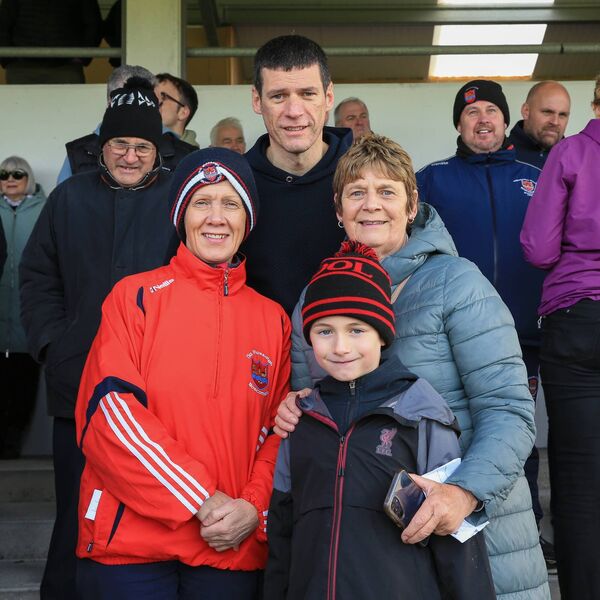An upset is likely, but in which game?

Saoirse Harney and Íosla Dillon supporting Clann na nGael during their recent senior football championship quarter-final victory against Elphin in Strokestown. Picture: Gerard O'Loughlin
I’ve put off writing this multiple times over the last few hours. It’s Sunday night. Shane Lowry has just stitched his approach shot on 18 to eight feet. It’s fantastic TV. We thought this might be an anti-climax given how far ahead Europe were, but it’s been anything but.
I’m hopeful we’ll also get plenty of excitement from the massive weekend in store for Roscommon football fans. It’s semi-finals weekend and I’m looking forward to seeing the senior games in particular.
Pearses and Brigid’s will be obvious favourites to win. That doesn’t mean it's a fait-accompli though. Faithleach’s and Clann have their fair share of top-quality footballers too. If they can get on top at kickouts and nail two-pointers, they’ll have every chance of causing upsets.
Meanwhile, Lowry has just drained the putt and Europe have retained the Ryder Cup. There are incredible scenes over in New York. It’s brilliant to watch. I can switch the telly off now at last.
So let’s look at the possibility of upsets this weekend. While we’re all still adapting to the new rules in place, there are some growing trends, which are hard to ignore.
The importance of winning primary possession has jumped up a huge amount over the past year. Most kickouts are long. If you’ve got big lads who can win it cleanly or a few whipper-snappers who mop up breaks for fun, then you’re in business.
The added bonus in winning long kickouts is that it is when defences are most vulnerable. We’re seeing a lot of scores arising from quick movement of the ball after winning a long kickout — all before the opposition has a chance to fall back into a deep defensive set-up.
The battle for possession has become so much more important simply because teams who have the ball now are likely to score. This wasn’t the case a year ago.
Now, even against well-drilled defences, with a maximum of 11 defenders, there’s just too much space, and good attackers will inevitably find it and make hay. This is one of the great successes of the new rules. It’s no longer profitable for a team to let their opponents win a short kickout and fall back into a “low block” defence.
This increased importance of winning kickouts also extends to turnovers in general play. The two favourites this weekend have proven to be the best teams at counter-attacking so far in this championship. They love to get bodies in around a tackle, force the turnover and hit their opponents when they’re out of position. Both teams’ speed of support play is of the highest order.
All this points to the underdogs needing to ensure they can win the possession battle if they’re to pull off a big win. You’d imagine Clann will need massive performances from the likes of Ultan Harney and Dylan Sumner in the middle of the field. They’ll also need to restrict Brigid’s to as few counter-attacking opportunities as possible — that means not losing the ball in the tackle or taking needless risks.
Another trend is the value of two-pointers, both literally and figuratively. In certain conditions, they are having massive impacts in games. Basically, if there’s a decent breeze blowing up or down the field, then the team playing with it needs to clock up their fair share of doubles.
The two-pointers can generate huge momentum swings in games. Leads of seven or eight points can evaporate very quickly. A long-range score was always a big fillip for a team, but now that that’s also reflected on the scoreboard, it has huge significance.

The weather is an important factor. If it’s a cold, wet day, the orange flag will rarely be seen, but if there’s a vertical wind on the pitch and the air is dry, get ready for big moments made by big scores.
Those are the kind of conditions in which I see Faithleach’s having the best chance of defeating Pearses. If it comes down to a game of who can shoot best from distance, the Ballyleague men are as good as anyone. Now, to be fair to Pearses, they’re no slouches in this department either, but it’s definitely that kind of shootout, which most suits Faithleach’s.
Another aspect of the games I’ll be watching with interest will be the “slow” attacks and how best to defend them. I think, broadly, there are two main types of attacks we’re seeing now. There are “quick” attacks which happen when a team win a kickout or a turnover and they move it quickly and get a shot off before defences have time to retreat into a shape.
The slow attacks happen when the defending team manages to delay the attack and funnel players back into a zonal defensive system. This is happening in each game we see — every team are doing it. The response of the team in possession then, upon seeing the zonal defence clogging up space in and around the D, is to slow things down and move the ball over and back across the field, probing, until they find an opening.
If the weather conditions are favourable for shooting, then defences need to squeeze out a bit more to deny long-range shooting opportunities. Most of the time, we’re seeing teams setting up a defensive line around the edge of the arc.
We are rarely seeing teams squeezing up completely and trying to get the ball back off their opponents as quickly as possible. This only happens at the end of games if the opposition is leading and running down the clock.
I have a feeling that the next big improvement we see from teams might be in this regard — coming out of the zonal defence on those slow attacks and getting the ball back quicker or forcing the opposition into a rushed attack and mistake. As it is, attacking teams are very good at generating scores from slow attacks. From a defensive coaching point of view, something has to change.
There are murmurings that the FRC is considering a further rule change for next year whereby a rule similar to basketball’s backcourt rule would be introduced. Once a team have possession past the halfway line, they can’t retreat back into their own half. I like the idea of this rule. It would fast-track that tactical improvement I’m talking about.
Teams would now be encouraged to go man to man on their opponents as the team in possession would have less space to play keep-ball in. Man on man marking would really be rewarded. It would also lead to more turnovers and more “fast” attacks. It’s a win-win situation as I see it.
Will any team be brave enough to stick to man on man defending this weekend? Clann have the personnel to attempt that kind of game, and it would, in my opinion, give them their best chance of defeating Brigid’s.
Looking through the list of semi-finals in senior, intermediate and Junior A level, which are all down for decision this weekend, it’s probably easy enough to pick out the favourite in each of them. Éire Óg against St Michael’s in the intermediate is probably the tightest one to call.
I’m not going to try to predict them all, but one thing I’ll say is this — there’ll surely be at least one team who’ll upset the odds. Who will it be?






